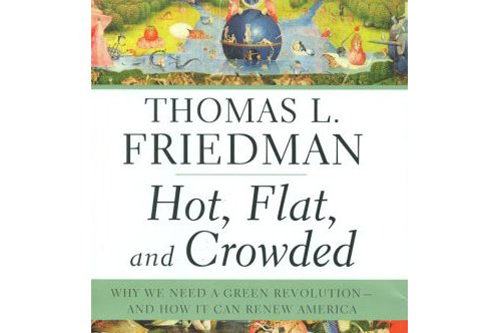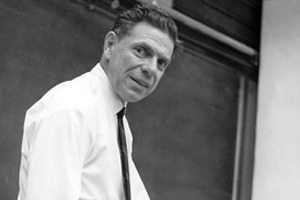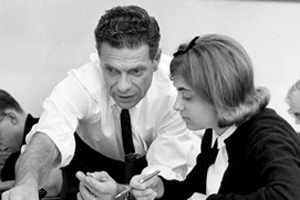Meeting global challenges, naturally
Ninety minutes into a breathless summary of the Earth’s historic climate cycles, Geology Professor Rhawn Denniston reaches the Al Gore moment.
He’s covered the epic forces that have shaped life on Earth, from meteors to glaciers to monsoons to sunspots in a dizzying, persistent march of charts and graphs. Now, pointing to a thin line representing atmospheric CO2 levels that began heading skyward 50 years ago, Denniston asks a simple, heart-stopping question: “Is human civilization in danger of collapse?”
An hour later the students will listen to a more hopeful talk from an anthropologist’s perspective as Phi Beta Kappa Visiting Scholar Anna Tsing describes communal efforts in Japan to restore red pine forests in which prized matsutake mushrooms thrive. All this after beginning the day with a trip to Iowa City to hear Nobel-winning biologist E.O. Wilson speak on the importance of species diversity and Darwin’s legacy.
Welcome to ENV 101.
Interdisciplinary solutions
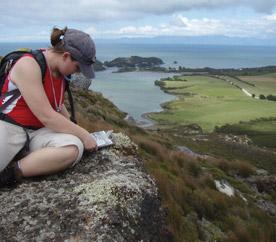
This new introductory course in environmental studies aims to give students an immersion into the global environmental challenges facing humanity, ranging from global warming to mass extinctions to increasing conflicts over scarce natural resources. Led this time by Biology Professor Andy McCollum and English Professor Glenn Freeman, the interdisciplinary course included guest lectures by Cornell faculty and other visitors in philosophy, economics, physics, geology, biochemistry, English, and sociology.
“The goal is to start students with an awareness not only of the breadth of the challenges, but also the breadth of where solutions may come from,” McCollum said. “As a biologist, I can understand the challenges to biodiversity, but I can’t solve the problems—I have to rely on policy makers, economists, poets, and others.”
Sophomore Emily Krauter says this interdisciplinary focus has opened her eyes to new ways of seeing environmental issues. While she’s become especially drawn to geology and climate studies after a summer of research with Denniston on stalagmites in New Mexico, she cites A’amer Farooqi’s Global Environmental Economics course as one of the most memorable.
“I always wondered why people don’t just help the environment,” Krauter said. “It was interesting to learn that it isn’t just greed and Big Oil that are the problem; there are actually economic reasons for not focusing on the environment, even if I don’t agree with them.”
Field opportunities
Interdisciplinary learning also abounds at the two field stations Cornell faculty use regularly. The Wilderness Field Station in northern Minnesota plays host to multiple courses during Block 1 each year. This year the Cornell Wilderness Term included two biology courses: McCollum’s Ecology and Marty Condon’s Plant Morphology, as well as Wilderness Politics taught by Craig Allin and a nature-based literature and photography course taught by English Professor Leslie Hankins.
Allin says these wilderness courses cause students to connect with their educational experience in a deeper way precisely because they’re disconnected from everything else. Without electricity and their normal routine, Allin says the students read, talk to one another, pitch in with camp chores, and behave in ways they never would on campus. Allin often finds students howling at wolves in hopes of hearing them howl back, or congregated on boulders in the dark waiting for glimpses of the northern lights and wondering why the sky is filled with so many unfamiliar constellations.
“It’s kind of a miraculous thing that happens when you get students away from all those distractions,” Allin said. “It amps up the educational
experience and amps up the human experience at the same time.”
Similar experiences, though warmer, are had at the Gerace Research Centre (GRC) on San Salvador Island in the Bahamas each February. At the GRC, students in molecular biology, organismal biology, and geology all add to ongoing research on fire coral from a range of perspectives. Meanwhile, students in Applied Anthropology investigate issues such as the impacts of resort on the local culture.
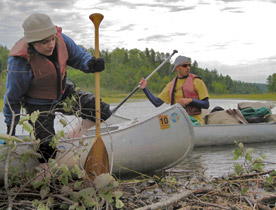
Canoe Area Wilderness as part of a 2008 Wilderness Politics course. (Photo by Craig Allin)
Cornell’s environmental studies program even offers a major track in marine science, a rarity among small Midwestern schools, coordinated by
Geology Professor Ben Greenstein. Senior Ben Rees came to Cornell with numerous transfer credits in biology, and found marine science to be a perfect way to integrate the new-found interest in geology that he discovered at Cornell.
“The combination of biology and geology classes has given me a unique perspective from my peers,” Rees said. “By combining modern information from a biology perspective with the historical context provided by geology, I think I gain a better picture of how the world works.”
Rees, who plans to attend graduate school in marine science, conducted research last summer on zooplankton as a Cornell Fellow at the Baruch Institute Marine Field Laboratory in South Carolina. The opportunity was sponsored by John Dean ’58, who also recently helped organize a 50th reunion class gift to the environmental studies program in honor of Herb Hendriks ’40, founder of environmental studies at Cornell and professor emeritus of geology.
For the future
Denniston, who serves as chair of environmental studies, hopes that the program will soon develop a third field station in Latin America. This one, he says, may be more of a virtual site so that professors ranging from Condon to David Yamanishi in politics to Carol Lacy-Salazar in Spanish might find unique locations to suit their individual course needs.
The program will also soon develop a capstone course. For his part, McCollum envisions that students might take an idea that began simmering back in ENV 101 and pursue it further through a major research project. He believes such a project ought to be more policy oriented than the types of basic research undertaken by traditional science majors, perhaps even involving work in a governmental or advocacy organization.
Freeman sees an even larger potential role for ENV 101. In his mind, the course should be required of all Cornell students, given the magnitude and urgency of the challenges presented by climate change and related issues.
“If we are going to live for the long term on the one planet we have, we eventually have to start living differently somehow,” Freeman said. “So I’d rather educate 100 percent of our first-year students than just 10 percent to think that way.”
Freeman and McCollum also came away from their first ENV 101 experience with a renewed appreciation for the liberal arts in general and the role of the humanities in particular. Both cite a lecture and class visit by renowned environmental writer Scott Russell Sanders as one of the course highlights.
“I was astonished at how many things in his discussion connected with the topics we’d been covering in class,” Freeman said. “He was the person who naturally pulled lots of threads together, and he reinforced for me the centrality of what I do.”

